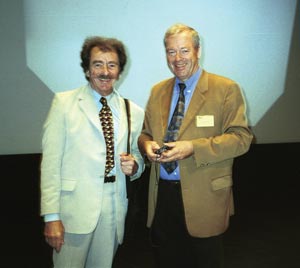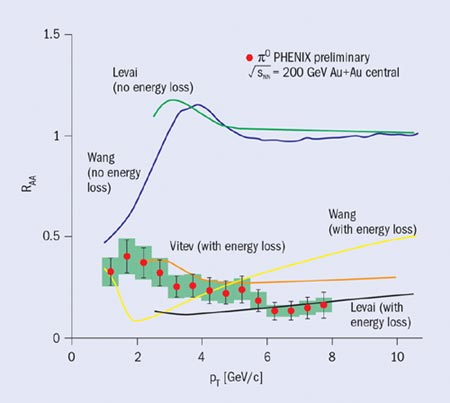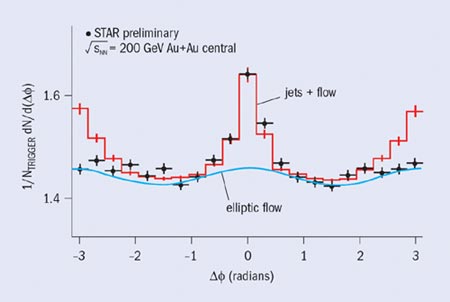Following the 2000 announcement by the CERN heavy-ion community of evidence for a new state of unbound quark-gluon matter, heavy-ion physicists have been eagerly awaiting results from Brookhaven’s RHIC. At the QM 2002 conference, they got their first major glimpse, as conference chair Hans Gutbrod and Thomas Peitzmann report.

At a seminar in February 2000, spokespersons from CERN’s heavy-ion experiments presented compelling evidence for the existence of a new state of matter in which quarks, instead of being bound up into more complex particles such as protons and neutrons, are liberated to roam freely. The seminar marked a turning point in heavy-ion research, with the spotlight turning to the other side of the Atlantic, where the Brookhaven Laboratory’s Relativistic Heavy-Ion Collider (RHIC) was about to switch on. Would the RHIC data corroborate or contradict CERN’s findings at the lower-energy programme? Most of the hadronic signals measured at RHIC so far have confirmed the CERN data and their interpretation, but new findings on high transverse momentum (pT) physics at RHIC have opened up a new avenue of enquiry. The impressively rich harvest of data from the first running periods of RHIC made QM 2002 a major milestone in the quark matter (QM) conference series.
The French town of Nantes was chosen to host QM 2002 last July in recognition of its importance as a focus for French heavy-ion research. As the home of the SUBATECH laboratory, founded in 1995, Nantes leads French participation in the ALICE heavy-ion experiment in preparation for the Large Hadron Collider (LHC) at CERN. The six-day conference programme saw 46 plenary talks and debates, 100 parallel session talks and more than 150 posters. Many of the speakers were appearing for the first time at a QM conference, the vanguard of a new generation to carry forward the physics of this field. The 700 participants came from all over the world.
Claude Détraz of CERN formally opened the conference, in the presence of the president of the Pays de la Loire regional council, with a look back at more than 20 years of heavy-ion history at CERN. It all began with the proposal of a US-German collaboration to bring a heavy-ion injector to CERN to do physics at the laboratory’s proton synchrotron. This idea evolved into a physics programme at the super proton synchrotron (SPS), leading to a lead-ion beam being built by a consortium from France, Germany, Holland, India, Italy and Sweden, together with CERN. The result was a fully-fledged research activity at CERN that will continue with the LHC.
Results from CERN
The search for a new state of strongly interacting matter at CERN started with beams of oxygen in 1986, and has continued with lead beams since 1994. The SPS fixed-target programme still has several experiments taking data, and many of those that have completed data-taking are still delivering physics results. Measurements of hadronic observables (strange and non-strange particles, flow and interferometry) are now becoming complete thanks to the measurements of the NA49, CERES and NA57 experiments, which were discussed by Christoph Blume of the German GSI laboratory, Marco van Leeuwen of Holland’s NIKHEF, Johannes Wessels of GSI, and Vito Manzari of the Italian INFN laboratory in Bari. Many of these studies have revealed interesting phenomena, which are also observed at RHIC.
New measurements at lower SPS energies allow excitation functions to be studied. These reveal interesting features, such as an indication of a maximum strangeness enhancement in an energy range between that achieved by Brookhaven’s Alternating Gradient Synchrotron and the top SPS energies. Statistical effects dominate fluctuations to a large extent, but detailed studies have revealed small non-statistical fluctuations. This was discussed by Bedanga Mohanty of Calcutta. Stefan Bathe of Münster presented results on high pT studies from the WA98 experiment. These do not exclude small jet-quenching effects (suppression of jets through medium-induced energy loss of hard-scattered partons) for very central lead-lead collisions compared with peripheral collisions. However, the clear suppression seen at RHIC is not observed at the SPS. Jet-quenching appears to be a signal that will be clearly accessible only at the colliders.
The most striking observation relevant to quark-gluon plasma formation is the suppression of J/y particles as measured by the NA38 and NA50 experiments at CERN. Luciano Ramello of the University of Piedmont Orientale presented improved data on J/y from NA50, with much better quality for peripheral reactions. Moreover, detailed momentum distributions of J/y are now available to constrain theoretical calculations. Philippe Crochet of Clermont Ferrand pointed out that data on J/y deserve a fresh look to understand all the details. Final results from the improved CERES experiment and the measurements of open charm, which will be performed by NA60, are eagerly awaited.
Results from RHIC
While the SPS heavy-ion programme has reaped most of its harvest, results from the RHIC experiments only started to appear at last year’s QM conference at Stony Brook, US, and became plentiful at this conference. Results on hadronic observables were presented by all four RHIC experiments in talks by Ian Bearden of the Niels Bohr Institute (NBI) for BRAHMS, Tatsuya Chujo of Tsukuba for PHENIX, Mark Baker of Brookhaven for PHOBOS, and by Lenny Ray of the University of Texas and Gene van Buren of Brookhaven for STAR. Their contributions took in global observables; spectra and yields of identified hadrons; interferometry; momentum, isospin and charge-fluctuations; and elliptic flow.
Full justice can only be done to all the new results from RHIC in the conference proceedings, but it is worthwhile drawing attention to some highlights. The ratios of produced particles can be described very accurately by statistical models of hadronization as discussed by van Buren, Chujo and Bearden for the experiments, and from the theory side by Andrzej Bialas of Krakow’s Jagellonian University, Johann Rafelski of Arizona, and Volker Koch of Berkeley. This was already seen at the SPS, and can also be successfully applied to lower-energy heavy-ion reactions and to proton-proton and electron-positron reactions. Whether these statistical distributions are of thermal origin, or whether they are merely related to phase space dominance is not at all clear. Thermal concepts may be applicable to high-energy heavy-ion reactions, but this appears much more unlikely for electron-positron reactions. Interestingly, the associated “chemical temperature” for high-energy nuclear reactions is very close to the postulated phase-transition temperature.
Interferometry of charged pions leaves us with a few unresolved puzzles, as discussed by Ray and Chujo. The duration of emission of the most abundant particles appears to be very short. The apparent size of connected regions of the expanding fireball has similar dimensions in the radial and the tangential directions, unlike the predictions of most models for the expansion. The phase space density of pions is apparently very high, which can be interpreted in terms of very low entropy per pion.
The asymmetry of particle emission in the transverse plane (known as elliptic flow), which showed up in non-central heavy-ion reactions at lower energies, has not only survived at RHIC, but is even stronger as was demonstrated in the talks by Ray, Chujo and Baker. Since hydrodynamical models are so far the most successful in describing the features of this asymmetry, this is one of the strongest hints of an early local equilibration of the system. The strength of the asymmetry is still finite for very large transverse momenta, where one would expect production from hard scattering to dominate over any equilibrated contribution. This may be seen as a hint of asymmetric jet-quenching in the reaction zone; the quantitative interpretation is, however, not yet settled.
Fluctuations and multiparticle correlations may help in finding hints of new physics. Results on various different approaches were presented, with Ray giving one example from STAR. He proposed an interpretation in terms of very late hadronization in central collisions.
Jet-quenching

At QM 2002, it became even clearer than at last year’s QM conference that RHIC has truly opened up the domain of hard scattering. This is particularly interesting, as it should allow the predicted jet-quenching to be used as a signature of the hot, dense medium. Rudolf Baier of Bielefeld discussed jet-quenching in detail. Hadron spectra have been measured by all experiments and were presented in the talks by Saskia Mioduszewski of Brookhaven for PHENIX, Gerd Kunde of Yale for STAR, Christof Roland of MIT for PHOBOS, and Claus Jørgensen of NBI for BRAHMS. Only PHENIX and STAR have measured out to truly high momenta. Their spectra are compared to the expectation from proton-proton reactions. This is commonly done by calculating a so-called nuclear modification factor (RAA), the ratio of spectra in nucleus-nucleus collisions to those in proton-proton collisions scaled by the number of possible binary nucleon-nucleon collisions within a heavy-ion reaction. Of particular importance was the measurement of neutral pions out to pT = 10 GeV/c by PHENIX. This measurement is important, because the neutral pion can be well identified out to such high pT and because PHENIX has also measured the spectra for proton-proton reactions within the same apparatus. The nuclear modification factor, which should be equal to 1 without any nuclear effects, is significantly below 1 up to the highest momenta analyzed (figure 1). Also shown in figure 1 are results of theoretical calculations with and without energy loss (jet-quenching). Calculations without energy loss miss the data completely. Calculations including energy loss provide the right order of magnitude for RAA, but still fail to describe the data exactly.
While the suppression in inclusive spectra shown in figure 1 is quantitatively the best-established indication of jet-quenching, it is much more fascinating to see hints of jet structures themselves. Indications of such angular correlations relative to a high-momentum trigger particle, both at small angles and back to back, were discussed by David Hardtke of Berkeley for STAR and by Mioduszewski for PHENIX. STAR presented the most advanced analysis of these correlations, and was able to demonstrate modifications of the jet structures for central gold-gold collisions (figure 2). The trigger jet appears to be almost unaltered. The counter jet, however, is completely suppressed in central collisions. The quenching of jets relative to the expectation from the proton-proton case appears to be established. Nevertheless, the interpretation of this phenomenon is not completely clear. One of the major open questions remaining is that of the composition of the high pT distributions of different particle species. Results from PHENIX seem to indicate that pions make up only around half of all charged hadrons even at very high pT, in contradiction to expectations from perturbative quantum chromodynamics (QCD).
The study of rare probes at RHIC, such as J/y and direct photon production, is still under way. PHENIX collaboration members James Nagle of Columbia and Klaus Reygers of Münster presented the status of these analyses. Such results are likely to contribute to the experimental highlights of the next QM conference.
Looking ahead

The experiments have provided theorists with a huge amount of data to contemplate. Currently there is no comprehensive theory in sight that could describe all the data or even a larger fraction of them, as Brookhaven’s Robert Pisarski pointed out. Theories or models can describe limited sets of data, but for some observables even such attempts fail. For example, the precise shape of the nuclear modification factor observed at RHIC cannot be described. A lot of effort is needed in the coming years to close the gap between theory and experiment. Progress has so far been made in areas of limited scope. Pasi Huovinen of Minnesota pointed out how hydrodynamical models are successful in describing certain bulk properties of the reactions. Direct photon calculations have been stimulated by the available measurement of WA98, which apparently requires a hot initial state to be explained. François Gélis of Orsay discussed new ideas, including the precise treatment of the Landau-Pomeranchuk-Migdal effect, which predicts a suppression of low-energy photon production in a dense medium. Frithjof Karsch of Bielefeld said that the possible use of the maximum entropy method to calculate production rates is very promising. The idea of saturation has been developed to very fruitful theoretical recipes, as presented by Edmond Iancu of Saclay. Lattice calculations approach realistic parameter settings, but as Tsukuba’s Kazuyuki Kanaya pointed out, the question of the nature of the phase transition remains open. Zoltan Fodor of Eötvös University discussed the possibility of calculating properties of QCD at finite baryochemical potential on the lattice.
Future directions were the subject of the final sessions. The major avenue of quark matter research leads to the LHC heavy-ion programme, which was presented by Helsinki’s Keijo Kajantie and Paolo Giubellino of INFN Turin, where still higher-energy density and temperature at negligible net baryon density are expected. An important follow-up on the lower-energy front was presented by Jochen Wambach of Illinois, who discussed a new facility at GSI that aims to study the highest net baryon densities.







